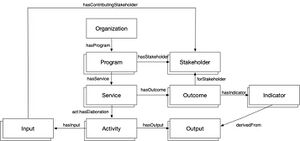Pattern:City Service Pattern
Description
An English description of the definition (what distinguishes this sense of the term?).
Cities provide a variety of services to residents and businesses, including health and social services. The city service pattern, is based on the Canadian Government Reference Model (CGRM), depicted in Figure 3. It identifies the following concepts as a basis for understanding the services that governments (Wiseman, 2015): • Programs are major city initiatives that address the needs of their constituents (citizens, clients). They are a mandate to achieve Outcomes by delivering Services. For example, ending homelessness. “For the citizens and clients of government, programs are abstract, whereas services are real. They represent the point of interaction between governments and their clients.” (Wiseman, 2015) • Services deliver outputs to clients that contribute to program outcomes. For example, providing shelters for the homeless. • The processes are activities that deliver services. For example, homeless person registration, bed allocation, etc. • Resources are used in carrying out processes. For example, shelter space, beds, and personnel.
Key Concepts and Classes
A Program defines a set of services that focus on a shared set of Outcomes. For example, a “poverty reduction program” can be made up of a set of Services such as mobiles services that provides food and clothing to those that live on the street, and a training service that provides basic skills for those living on the street. A Program has a set of Stakeholders that can contribute or benefit. The following are the Program properties: • hasService: Identifies the Services that make up the Program. • hasOutcome: Identifies the Outcomes that the program is trying to achieve. • hasContributingStakeholder: Identifies the stakeholders that contribute to the Program. • hasBeneficialStakeholder: Identifies the stakeholders that benefit from the Program. • hasInput: Identifies the Inputs to the Program. • hasOutput: Identifies the Outputs of the Program. A Program is composed of one or more Services. As described in the Program description, a poverty reduction program can have many services with each service comprised of different activities, Inputs, Outputs and Outcomes. The following are the Service properties: • activity:hasSubActivity: Identifies the Activities that make that comprise the Service. • hasInput: Identifies the Inputs to the Service. • hasOutput: Identifies the Outputs of the Service. • hasOutcome: Identifies the Outcomes that are specific to the Service. • hasContributingStakeholder: Identifies the stakeholders that contribute to the Service. • hasBeneficialStakeholder: Identifies the stakeholders that benefit from the Service. Outcome’s “are what stakeholders experience as a result of a city Programs and/or Services. They can be positive or negative, intended or unintended.” Outcome contains the following properties: • hasBeneficialStakeholder: Identifies the Stakeholder affected. • hasIndicator: Identifies the set of Indicators the organization assigns to the Outcome. • schema:description: A general description of the Outcome as a string. • fromPerspectiveOf: Identifies the Stakeholder who is determining the importance of the Impact. • hasImportance: Specifies how important the Impact is (high, medium, low). • intendedImpact: Identifies the intended direction of the change. Stakeholder is a person or organization that either contributes to or benefits from a Program and/or Service. It has the following properties: • schema:name (title): A title for the stakeholder as a string. • schema:description: A general description of the stakeholder as a string. • hasCatchmentArea: Specifies the regional span of the stakeholders. • perform: Links to the activities performed by the stakeholder. Input defines the resources and the stakeholders that contribute them that are input to an Activity: • forActivity: The Program or Service or Activity this is an input for. • hasContributingStakeholder: The Stakeholders that contribute the resources as input. • hasResource: Specifies the input Resource. • hasPlannedAmount: Specifies the amount of the input Resource • hasActualAmount: Specifies actual amount of input Resource used. • i72:for_time_interval: Specifies the time interval over which the input is used. • sch:name: Name for the Input. • sch:description: Description for the Input. Output is a quantitative summary of an activity. For example, if the activity is ‘we provide training’ and the output is ‘we trained 50 people to NVQ level 3’. Or a production output could produce 100 meals for the homeless. Basic to these outputs is “what” has been produced and the quantity. • forActivity: Identifies the Activity or Service that produces the Output. • i72:value: Identifies that amount that is produced. • hasResource: Identifies the Resource that is produced such as a skill, or a type of Meal. • usedByIndicator: Identifies the Indicators that use this Output in determining the value of the Indicator.
Has Class(es)
Program, Service, Outcome, Stakeholder, Input, Output ISO5087-1:Activity
Status
Pending Approval
Supplementary Figures
| Figure | Caption |
|---|---|
| City Service Pattern |
